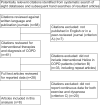Heliox, dyspnoea and exercise in COPD
- PMID: 20956163
- PMCID: PMC9491633
- DOI: 10.1183/09059180.00006009
Heliox, dyspnoea and exercise in COPD
Abstract
One of the most important determinants of physical and mental well-being of people with chronic obstructive pulmonary disease (COPD) is participation in physical activity. The ability to alter the sensation of dyspnoea during exercise may improve both exercise duration and intensity. Despite the low density, inert nature, strong safety profile and multiple applications of helium gas, the potential benefit of helium-oxygen gas mixtures as an adjunct therapy to modify disease symptoms and exercise capabilities in obstructive lung diseases has only recently been explored. This is a systematic review of the available peer-reviewed evidence exploring whether symptom modification (perceived levels of dyspnoea) and exercise performance in COPD (either intensity or duration of work) are modified by inhalation of Heliox. Eight experimental studies met inclusion for this review. A variety of methodologies and outcome variables were used negating meta-analysis and hampering direct comparison between interventions. Overall, there was high level of evidence with a low risk of bias supporting Heliox's effectiveness in improving the intensity and endurance of exercise when compared to room air for people with COPD. Little conclusive evidence was found to determine whether Heliox altered the sensation of dyspnoea during exercise.
Figures
Comment in
-
Lighter than air: heliox breathing improves exercise tolerance in COPD.Eur Respir Rev. 2010 Mar;19(115):1-3. doi: 10.1183/09059180.00000210. Eur Respir Rev. 2010. PMID: 20956159 Free PMC article. No abstract available.
References
-
- O'Donnell DE. Hyperinflation, dyspnea, and exercise intolerance in chronic obstructive pulmonary disease. Proc Am Thorac Soc 2006; 3: 180–184. - PubMed
-
- O'Donnell DE, Laveneziana P. Dyspnea and activity limitation in COPD: mechanical factors. COPD 2007; 4: 225–236. - PubMed
-
- The COPDX Plan: Australian and New Zealand Guidelines for the management of Chronic Obstructive Pulmonary Disease 2009. www.copdx.org.au/guidelines/documents/COPDX_v2_18.pdf Last updated: April 2009. Date last accessed: September 12, 2009.
-
- American Thoracic Society. Management of Stable COPD. www.thoracic.org/sections/copd/for-health-professionals/management-of-st... Last updated: 2009. Date last accessed: September 12, 2009.
Publication types
MeSH terms
Substances
LinkOut - more resources
Full Text Sources
Medical
Miscellaneous


